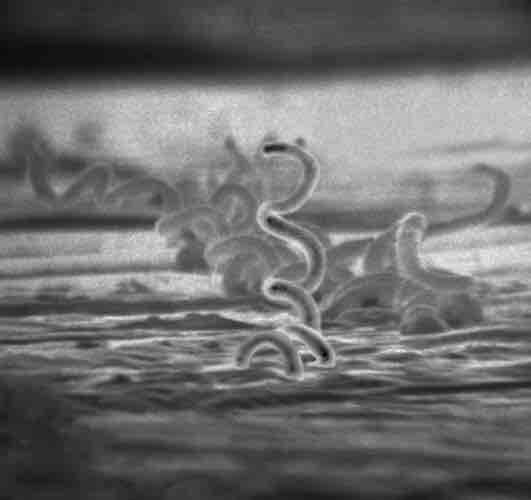Syphilis is a sexually transmitted infection caused by the spirochete bacterium Treponema pallidum subspecies pallidum . The primary route of transmission is through sexual contact; it may also be transmitted from mother to fetus during pregnancy or at birth, resulting in congenital syphilis. Other human diseases caused by related Treponema pallidum include yaws (subspecies pertenue), pinta (subspecies carateum) and bejel (subspecies endemicum).

Electron Microscopy of Treponema Pallidum
This electron micrograph shows Treponema pallidum on cultures of cotton-tail rabbit epithelium cells (Sf1Ep). It is the causative agent of syphilis.
The signs and symptoms of syphilis vary depending in which of the four stages it presents (primary, secondary, latent, and tertiary). The primary stage classically presents with a single chancre (a firm, painless, non-itchy skin ulceration), secondary syphilis with a diffuse rash which frequently involves the palms of the hands and soles of the feet, latent syphilis with little to no symptoms, and tertiary syphilis with gummas, neurological, or cardiac symptoms. It has, however, been known as "the great imitator" due to its frequent atypical presentations. Diagnosis is usually via blood tests; however, the bacteria can also be visualized under a microscope. Syphilis can be effectively treated with antibiotics, specifically the preferred intramuscular penicillin G (given intravenously for neurosyphilis), or else ceftriaxone, and in those who have a severe pencillin allergy, oral doxycycline or azithromycin.
Syphilis is believed to have infected 12 million people worldwide in 1999, with greater than 90% of cases in the developing world. After decreasing dramatically since the widespread availability of penicillin in 1940s, rates of infection have increased since the turn of the millennium in many countries, often in combination with human immunodeficiency virus (HIV). This has been attributed partly to unsafe sexual practices among men who have sex with men, increased promiscuity, prostitution and decreasing use of barrier protection.
Primary
Primary syphilis is typically acquired by direct sexual contact with the infectious lesions of another person. Approximately three to 90 days after the initial exposure (average 21 days) a skin lesion, called a chancre, appears at the point of contact. This is classically (40% of the time) a single, firm, painless, non-itchy skin ulceration with a clean base and sharp borders between 0.3 and 3.0 cm in size. The lesion, however, may take on almost any form. In the classic form, it evolves from a macule to a papule and finally to an erosion or ulcer. Occasionally, multiple lesions may be present (~40%), with multiple lesions more common when coinfected with HIV. Lesions may be painful or tender (30%), and they may occur outside of the genitals (2–7%). The most common location in women is the cervix (44%), the penis in heterosexual men (99%), and anally and rectally relatively commonly in men who have sex with men (34%).
Lymph node enlargement frequently (80%) occurs around the area of infection, occurring seven to 10 days after chancre formation. The lesion may persist for three to six weeks without treatment.
Secondary
Secondary syphilis occurs approximately four to ten weeks after the primary infection. While secondary disease is known for the many different ways it can manifest, symptoms most commonly involve the skin, mucous membranes, and lymph nodes. There may be a symmetrical, reddish-pink, non-itchy rash on the trunk and extremities, including the palms and soles. The rash may become maculopapular or pustular. It may form flat, broad, whitish, wart-like lesions known as condyloma latum on mucous membranes. All of these lesions harbor bacteria and are infectious. Other symptoms may include fever, sore throat, malaise, weight loss, hair loss, and headache. Rare manifestations include hepatitis, kidney disease, arthritis, periostitis, optic neuritis, uveitis, and interstitial keratitis. The acute symptoms usually resolve after three to six weeks; however, about 25% of people may present with a recurrence of secondary symptoms. Many people who present with secondary syphilis (40–85% of women, 20–65% of men) do not report previously having had the classic chancre of primary syphilis.LatentLatent syphilis is defined as having serologic proof of infection without symptoms of disease. It is further described as either early (less than 1 year after secondary syphilis) or late (more than 1 year after secondary syphilis) in the United States. The United Kingdom uses a cut-off of two years for early and late latent syphilis. Early latent syphilis may have a relapse of symptoms. Late latent syphilis is asymptomatic, and not as contagious as early latent syphilis.
Tertiary
Patient with tertiary (gummatous) syphilis. Bust in Musée de l'Homme, Paris.Tertiary syphilis may occur approximately three to 15 years after the initial infection, and may be divided into three different forms: gummatous syphilis (15%), late neurosyphilis (6.5%), and cardiovascular syphilis (10%). Without treatment, a third of infected people develop tertiary disease. People with tertiary syphilis are not infectious. Gummatous syphilis or late benign syphilis usually occurs one to 46 years after the initial infection, with an average of 15 years. This stage is characterized by the formation of chronic gummas, which are soft, tumor-like balls of inflammation which may vary considerably in size. They typically affect the skin, bone, and liver, but can occur anywhere.
Neurosyphilis refers to an infection involving the central nervous system. It may occur early, being either asymptomatic or in the form of syphilitic meningitis, or late as meningovascular syphilis, general paresis, or tabes dorsalis, which is associated with poor balance and lightning pains in the lower extremities. Late neurosyphilis typically occurs four to 25 years after the initial infection. Meningovascular syphilis typically presents with apathy and seizure, and general paresis with dementia and tabes dorsalis. Also, there may be Argyll Robertson pupils, which are bilateral small pupils that constrict when the person focuses on near objects, but do not constrict when exposed to bright light.Cardiovascular syphilis usually occurs 10–30 years after the initial infection. The most common complication is syphilitic aortitis, which may result in aneurysm formation.